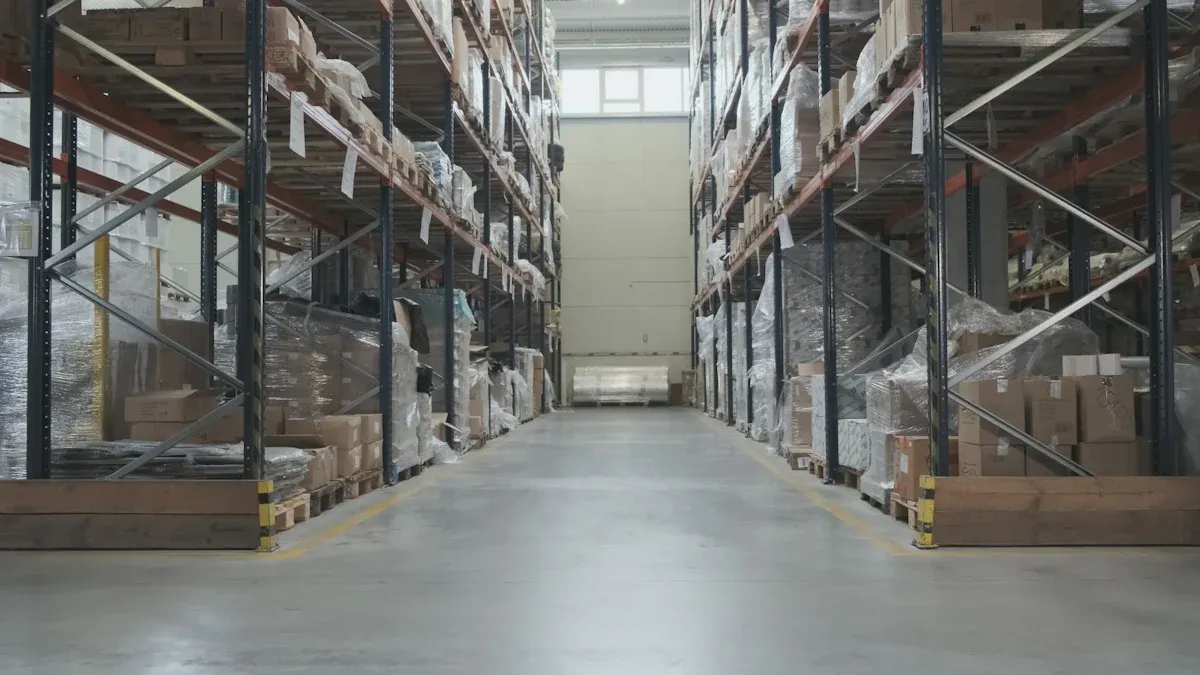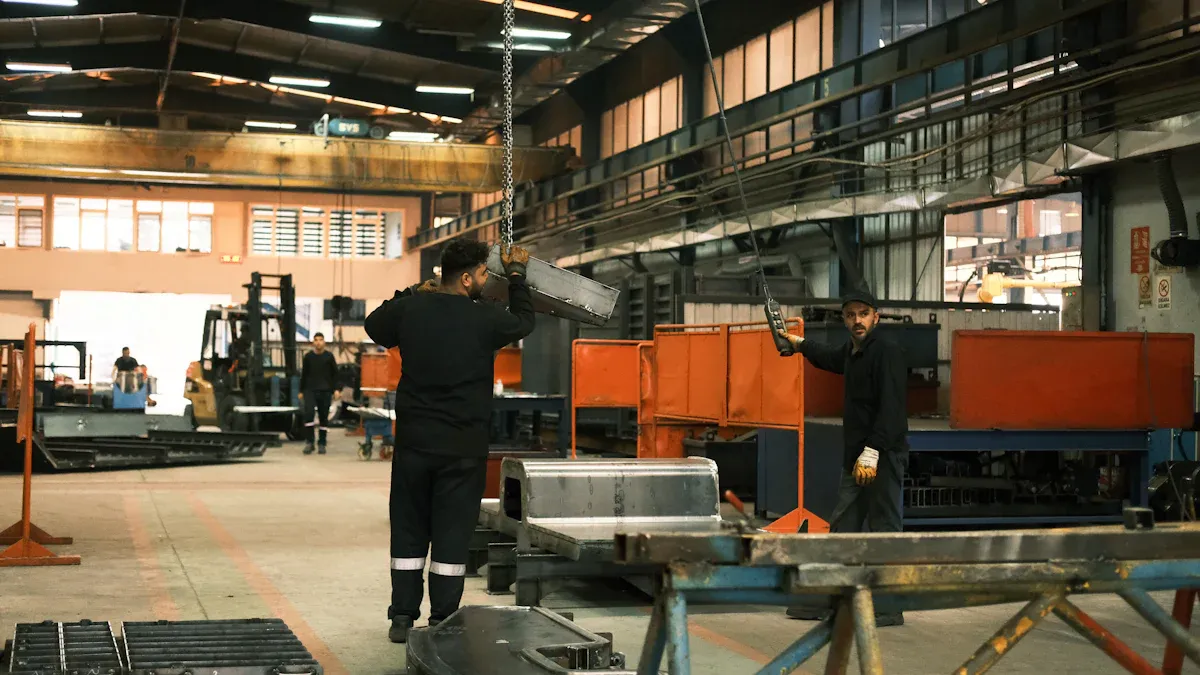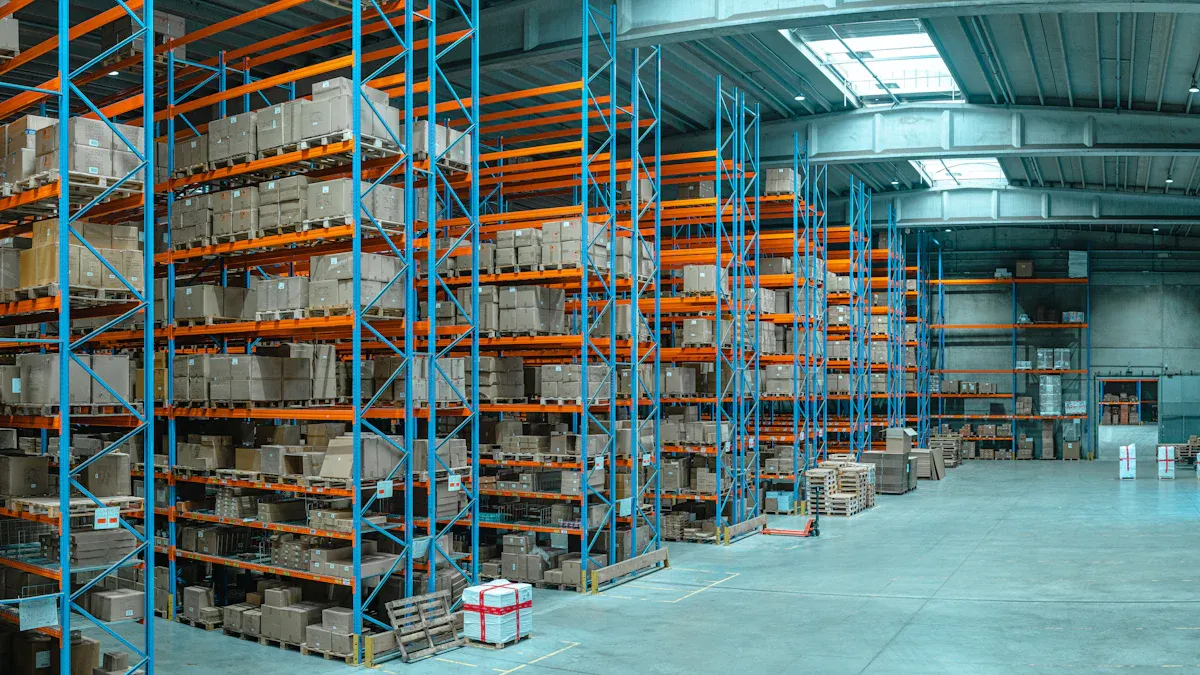Common Pain Points in In‑Plant Logistics in Manufacturing

Efficient in-plant logistics plays a pivotal role in manufacturing success. Addressing pain points in this area ensures smoother operations and enhances competitiveness in a fast-evolving industry. Rising consumer demand and an aging workforce exacerbate logistical challenges.
Over 2.71 billion people shop online today, with this number expected to reach 2.77 billion by 2025, driving higher order volumes and straining warehouse staff.
By 2050, the global share of citizens aged 65+ will grow from 10% to 16%, signaling the retirement of experienced workers.
Younger generations increasingly prefer less physically demanding roles, deepening the labor shortage and creating operational knowledge gaps.
These factors highlight the urgency of optimizing in-plant logistics to sustain efficiency and meet modern demands.
Key Takeaways
Clear processes in material handling lower mistakes and boost safety. Set clear rules to work faster and better.
Machines can help with fewer workers and do more work. Try using automated tools to need less manual effort.
Use machines wisely with good care and staff training. This keeps machines working longer and avoids breaks.
Keep the right amount of stock to meet needs. Check how fast items sell to avoid too much or too little.
Good communication between teams helps them work together well. Use tools and meetings to stay on track and avoid delays.
Pain Points in Material Handling

Lack of Standardized Processes
Standardized processes are essential for maintaining consistency and efficiency in material handling. Many manufacturing plants struggle with fragmented workflows, leading to operational inefficiencies and increased costs. Without clear guidelines, employees often rely on ad-hoc methods, which can result in errors and delays.
For example, unplanned downtime costs manufacturers approximately $50 billion annually. This financial burden highlights the consequences of inconsistent practices in material handling. Additionally, safety concerns arise when processes lack standardization. In 2021, 798 fatal work injuries were linked to exposure to harmful materials, underscoring the need for structured procedures to mitigate risks.
Manufacturers can address these pain points by implementing standardized workflows and leveraging technology to monitor compliance. This approach not only reduces errors but also enhances safety and operational efficiency.
Overreliance on Manual Labor
Manual labor remains a cornerstone of material handling in many manufacturing facilities. However, excessive dependence on human effort introduces several challenges, including slower operations, higher error rates, and increased safety risks.
Labor shortages exacerbate these issues. Younger generations often prefer less physically demanding roles, leaving manufacturing plants struggling to fill critical positions. Furthermore, turnover rates and training costs add financial strain. Companies must account for expenses related to safety (48%), training (47%), and labor availability (42%) when considering automation solutions.
Automation offers a viable solution to reduce reliance on manual labor. By integrating automated systems, manufacturers can enhance productivity, minimize errors, and improve workplace safety. This shift also addresses labor shortages by reducing the need for physically demanding tasks.
Poor Equipment Utilization
Inefficient use of equipment is another significant pain point in material handling. Many facilities fail to maximize the potential of their machinery, leading to wasted resources and operational bottlenecks. Poor equipment utilization often stems from inadequate maintenance schedules, lack of training, and outdated technology.
A staggering 74% of supply chain leaders are increasing technology spending to tackle these challenges. This investment reflects the growing recognition of the importance of optimizing equipment usage. Proper utilization not only reduces downtime but also extends the lifespan of machinery, saving costs in the long term.
Manufacturers can improve equipment utilization by adopting predictive maintenance strategies and training employees to operate machinery effectively. These measures ensure that equipment performs at its peak, contributing to smoother material handling processes.
Inventory Management Pain Points
Overstocking and Understocking
Balancing inventory levels remains one of the most critical challenges in manufacturing logistics. Overstocking ties up capital and increases storage costs, while understocking disrupts production schedules and leads to missed customer deadlines. Both scenarios negatively impact operational efficiency and profitability.
Several strategies can help mitigate these issues:
Monitoring inventory turnover rates provides insights into how frequently stock is sold and replaced. This metric helps manufacturers align inventory levels with actual demand.
Safety stock optimization uses statistical methods to balance service level targets against the costs of excess inventory. This approach ensures that manufacturers maintain adequate stock without overburdening storage facilities.
By adopting these practices, manufacturers can reduce waste, improve cash flow, and enhance customer satisfaction.
Tip: Regularly reviewing inventory turnover metrics can help identify slow-moving items and prevent overstocking.
Lack of Real-Time Visibility
Real-time visibility into inventory levels is essential for effective decision-making. Without it, manufacturers face challenges such as stock discrepancies, delayed order fulfillment, and inefficient resource allocation. Modern inventory management systems address these issues by providing immediate updates on stock movements and availability.
Key performance indicators (KPIs) play a vital role in evaluating the effectiveness of real-time visibility systems. Metrics such as order picking accuracy, cycle count accuracy, and time to receive shipments offer actionable insights. For example:
Metric | Description |
|---|---|
Immediate visibility into stock levels, tracking movements, and automatic updates after transactions. | |
Cost Management | Tools for tracking inventory investment and carrying costs, analyzing trends for cost reduction. |
Order Picking Accuracy | Measures the accuracy of order fulfillment, ensuring correct items are picked for shipment. |
Cycle Count Accuracy | Compares periodic cycle counts to recorded inventory, helping to maintain accurate stock levels. |
Time to Receive | Average time taken to receive and process shipments, identifying inefficiencies in the process. |
Implementing systems that track these metrics enables manufacturers to streamline operations, reduce errors, and respond quickly to changing demands.
Ineffective Tracking Systems
Outdated or inefficient tracking systems create significant pain points in inventory management. They lead to errors in stock counts, misplaced items, and delays in locating materials. These inefficiencies disrupt workflows and increase operational costs.
Modern tracking technologies, such as RFID and barcode systems, offer solutions to these challenges. They provide accurate, real-time data on inventory locations and movements. Additionally, integrating these systems with warehouse management software enhances traceability and reduces manual errors.
For example, businesses that adopt automated tracking systems report improved cycle count accuracy and faster order fulfillment. These benefits translate into higher customer satisfaction and better resource utilization.
Note: Investing in advanced tracking systems not only improves inventory accuracy but also supports long-term scalability.
Workflow Bottlenecks and Inefficiencies

Poor Layout Design
A poorly designed facility layout creates significant inefficiencies in manufacturing workflows. Excessive travel distances for raw materials, misplaced machinery, and delays in quality assurance processes are common outcomes. These inefficiencies not only slow down production but also increase operational costs.
Impact Factor | Description |
|---|---|
Travel Distance | Poor layout increases the distance raw materials must travel, affecting efficiency. |
Machinery Proximity | Inefficient layout can lead to machinery being far from necessary utilities, causing delays. |
QA Process Delay | A suboptimal layout can prolong the time from production to quality assurance, impacting output. |
Optimizing layout utilization can significantly improve production output. For instance, a proposed layout with 42.07% utilization led to better output management under fluctuating demand. Manufacturers should prioritize space conservation and strategic placement of equipment to minimize workflow disruptions.
Inadequate Coordination Between Departments
Lack of coordination between departments often results in misaligned priorities, resource wastage, and workflow interruptions. Effective communication and collaboration are essential to prevent these issues. Improved coordination can lead to higher productivity, faster service, and enhanced employee satisfaction.
Benefit Description | Impact |
|---|---|
Improved workflow efficiency | |
Faster service leading to enhanced customer satisfaction | Increased customer loyalty |
Increased employee engagement and satisfaction | Reduced stress and improved productivity |
Avoidance of unnecessary expenses through resource reallocation | More accurate and effective work delivery |
Manufacturers can address this pain point by implementing cross-departmental communication tools and regular alignment meetings. These measures ensure that all teams work toward shared goals, reducing bottlenecks and improving overall efficiency.
Delays in Material Movement
Delays in material movement disrupt production timelines and negatively impact customer satisfaction. These delays often arise from manufacturing issues, transportation disruptions, or inaccurate forecasting. In the machinery and plant manufacturing industry, even a single delayed component can postpone assembly, affecting delivery schedules and overall output.
According to Buildertrend's data, construction jobs experienced an average of 46.8 days of delays, a 117.5% increase from the previous year. This trend highlights the growing challenges in material movement. Manufacturers must adopt predictive analytics and real-time tracking systems to mitigate these delays. Streamlined material flow ensures timely production and enhances customer trust.
Tip: Regularly reviewing material movement processes can help identify inefficiencies and prevent costly delays.
Communication and Data Integration Challenges
Lack of Integration Between Systems
Disconnected systems create significant challenges in manufacturing logistics. When software and hardware fail to communicate effectively, data silos emerge, hindering decision-making and operational efficiency. For instance, inventory management systems that do not sync with production schedules can lead to delays and resource misallocation.
Integrated systems streamline workflows by enabling seamless data sharing across departments. Enterprise Resource Planning (ERP) solutions, for example, consolidate information from various sources, providing a unified view of operations. This approach reduces redundancies and enhances productivity. Manufacturers should prioritize system integration to address these pain points and improve overall efficiency.
Tip: Conduct regular audits of existing systems to identify integration gaps and implement solutions that align with operational goals.
Miscommunication Between Teams
Miscommunication often disrupts workflows and leads to costly errors. In manufacturing, unclear instructions or delayed updates can result in production halts, missed deadlines, and dissatisfied customers. For example, a lack of clarity between procurement and production teams may cause material shortages or overstocking.
To mitigate these issues, manufacturers should invest in communication tools that promote transparency and collaboration. Platforms like Slack or Microsoft Teams facilitate real-time updates and ensure all stakeholders remain informed. Regular team meetings and clearly defined roles further enhance coordination, reducing the likelihood of misunderstandings.
Note: Establishing a culture of open communication fosters trust and minimizes the risk of errors caused by miscommunication.
Absence of Clear Reporting Mechanisms
Without clear reporting mechanisms, tracking performance and identifying areas for improvement become challenging. Inconsistent or incomplete reports can obscure critical insights, delaying corrective actions. For instance, a lack of detailed production reports may prevent managers from identifying bottlenecks or inefficiencies.
Implementing standardized reporting frameworks ensures consistency and accuracy. Dashboards that display key performance indicators (KPIs) in real time provide actionable insights, enabling managers to make informed decisions. Metrics such as on-time delivery rates, inventory turnover, and equipment utilization should be included in these reports to offer a comprehensive view of operations.
Callout: Leveraging automated reporting tools reduces manual errors and saves time, allowing teams to focus on strategic initiatives.
Barriers to Technology Adoption
Resistance to Change
Resistance to change remains a significant obstacle in adopting advanced technologies in manufacturing logistics. Employees often hesitate to embrace new systems due to fear of job displacement or unfamiliarity with the technology. This reluctance slows down the transition to more efficient processes and creates operational inefficiencies.
To overcome this challenge, organizations must foster a culture of innovation. Leadership teams should communicate the benefits of technology adoption, such as improved safety, reduced workload, and enhanced productivity. Offering incentives and involving employees in decision-making can also ease the transition.
Tip: Regular workshops and open forums can help address employee concerns and build trust in new systems.
High Implementation Costs
The high costs associated with implementing advanced logistics technologies present another barrier. Many manufacturers struggle to justify the upfront investment, especially when operating on tight budgets. The following table highlights the cost considerations for various technologies:
Manufacturers can address these financial pain points by conducting cost-benefit analyses and exploring government grants or subsidies for technology upgrades.
Lack of Training and Expertise
A lack of training and expertise further complicates technology adoption. Employees often require reskilling to operate new systems effectively. Without proper training, the risk of errors and inefficiencies increases. The following chart illustrates the percentage of employees needing training and the duration required:
The data reveals that 53% of employees need reskilling or up-skilling, with 36% requiring training lasting up to six months. However, only 16% of respondents believe current courses align with industry needs. To bridge this gap, manufacturers should invest in tailored training programs that address specific operational requirements.
Callout: Partnering with educational institutions or industry experts can ensure training programs remain relevant and effective.
Addressing the pain points in in-plant logistics is essential for maintaining operational efficiency and staying competitive in the manufacturing sector. Challenges such as workflow inefficiencies, inventory mismanagement, and communication gaps can disrupt production and inflate costs. Proactive strategies, including adopting advanced technologies, fostering better communication, and prioritizing safety, can mitigate these issues effectively.
Manufacturers should regularly assess their logistics processes to identify areas for improvement. By taking actionable steps, they can enhance productivity, reduce waste, and meet evolving industry demands. A commitment to continuous improvement ensures long-term success in a dynamic market.
FAQ
Why is real-time inventory visibility important?
Real-time inventory visibility enables manufacturers to track stock levels, prevent discrepancies, and make informed decisions. It reduces delays, improves order accuracy, and ensures timely production, ultimately enhancing customer satisfaction and operational efficiency.
What are the benefits of adopting automation in logistics?
Automation reduces reliance on manual labor, minimizes errors, and improves safety. It enhances productivity, addresses labor shortages, and optimizes resource utilization, making it a cost-effective solution for modern manufacturing challenges.
How can manufacturers overcome resistance to technology adoption?
Manufacturers can overcome resistance by fostering a culture of innovation, offering training programs, and involving employees in decision-making. Clear communication about the benefits of new technologies helps build trust and encourages acceptance.
See Also
Enhancing Supply Chain Strategies for High-Tech Manufacturing
Achieving Success Through Lean Logistics in High-Tech Manufacturing
Boosting Warehouse Efficiency with Logistics Robotics Innovations
Expert Advice for Overcoming Automotive Supply Chain Challenges
